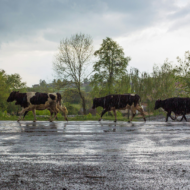Keeping Cattle Safe During Thunder Storms
Best Practices for Cattle Safety During Storms, Lightning, and High Winds
Go Back to All BlogsPosted on: December 11, 2025
Updated on: December 11, 2025
Author: Arrowquip
SHARE:
Cattle in a thunderstorm are in a very vulnerable position. In many cases, they may be the tallest point in a field, which puts them at risk of lightning strikes. In addition, thunder can scare cattle, causing panic, and potentially, even injuries.
While many smaller animals will seek shelter in a storm, cattle might not always do so. Worse, cattle may sometimes try to seek shelter under a tree, one of the most dangerous spots during a thunder and lightning storm.
What to Do With Cattle During a Thunder Storm
1) Know the weather.
Find out when thunderstorms are most likely in your region. For much of the country, they are most common in the spring and summer. Make sure you follow weather forecasts, and set up an automatic alert system on your mobile device or computer, so you'll be alerted in case a thunderstorm system moves into your area or a weather advisory is issued.
2) Create a three-sided shelter and install a lightning rod on your property.
A lightning rod can reduce the risk of lightning striking cattle or a building directly. A three-sided shelter gives cattle a better alternative for safety and keeps them protected and dry in a storm. With a good shelter, cattle may in fact be safer outdoors than they would be inside.
3) Keep your pasture and barnyards clear.
Remove debris, especially metal debris, on a regular basis. Not only can it attract lightning, but any debris can also become airborne in heavy winds and can pose a risk to any cattle nearby.

4) Ensure good drainage and elevation.
Ideally, keep cattle on higher ground so there's less danger of flash flooding during a storm. In addition, ensure proper drainage on pastures and fields where cattle graze, since waterlogged grasses and areas can cause added dangers and illnesses, including hoof problems and infections.
5) Anticipate possible dangers after a thunderstorm.
Have plenty of food and veterinary supplies on hand in case cattle are injured during a storm. Be prepared to cut off electricity if needed and take measures to protect your herd's water supply. During a storm, contamination can seep in due to pesticides and other hazards.
Since 1988, Arrowquip has been providing safer livestock handling solutions and products. We're proud to offer portable handling systems, squeeze chutes, corral panels, gates, bale feeders and other custom handling systems. Contact us today to stock up before a storm hits your area.